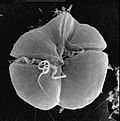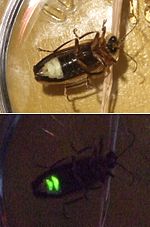The dinoflagellates (from Ancient Greek δῖνος (dînos) 'whirling', and Latin flagellum 'whip, scourge') are a monophyletic group of single-celled eukaryotes...
96 KB (10,319 words) - 18:59, 29 June 2024
Alexandrium is a genus of dinoflagellates. It contains some of the dinoflagellate species most harmful to humans, because it produces toxic harmful algal...
33 KB (4,817 words) - 13:31, 19 October 2023
Bioluminescence (redirect from Dinoflagellate light production)
The most frequently encountered bioluminescent organisms may be the dinoflagellates in the surface layers of the sea, which are responsible for the sparkling...
75 KB (8,132 words) - 03:31, 8 July 2024
Luciferase (section Dinoflagellate)
examples in other kingdoms including bioluminescent bacteria, and dinoflagellates. The luciferases of fireflies – of which there are over 2000 species...
27 KB (2,896 words) - 20:19, 27 June 2024
Calcareous dinoflagellate cysts or calcareous dinocysts are dinoflagellate cysts produced by a group of peridinoid dinoflagellates, called calcareous...
6 KB (720 words) - 02:33, 16 May 2023
Dinoflagellate luciferase (EC 1.13.12.18, Gonyaulax luciferase) is a specific luciferase, an enzyme with systematic name dinoflagellate-luciferin:oxygen...
9 KB (1,095 words) - 21:42, 1 September 2023
Dinoflagellates are eukaryotic plankton, existing in marine and freshwater environments. Previously, dinoflagellates had been grouped into two categories...
19 KB (2,021 words) - 17:20, 16 May 2024
named for Dr. Karen Steidinger for her exceptional contributions to dinoflagellate research. She has spent many decades researching Karenia brevis. 12...
12 KB (1,488 words) - 01:18, 13 March 2024
Predatory dinoflagellates are predatory heterotrophic or mixotrophic alveolates that derive some or most of their nutrients from digesting other organisms...
12 KB (1,225 words) - 22:01, 11 January 2024
Dinoflagellate Blooms is the fourth studio album that J. G. Thirlwell has issued under the pseudonym Manorexia. It was released on June 11, 2011 by Ectopic...
3 KB (113 words) - 03:56, 13 January 2021
Dinoflagellate/viral nucleoproteins (DVNPs) are a family of positively-charged, DNA-binding nucleoproteins found exclusively in dinoflagellates and Nucleocytoviricota...
2 KB (281 words) - 19:40, 3 December 2023
Scintillon (section Dinoflagellate light production)
produce light. Among bioluminescent organisms, only dinoflagellates have scintillons. Marine dinoflagellates at night can emit blue light by bioluminescence...
10 KB (1,282 words) - 12:41, 7 January 2023
remains from the Eocene of Barbados can be interpreted as dinoflagellate thecae of the dinoflagellate Peridinites. These have previously been interpreted as...
614 bytes (66 words) - 17:22, 12 February 2017
Dinocyst (redirect from Dinoflagellate cyst)
Dinocysts or dinoflagellate cysts are typically 15 to 100 μm in diameter and produced by dinoflagellates as a dormant, zygotic stage of their lifecycle...
87 KB (9,332 words) - 09:03, 2 June 2024
the island of Vieques famous for its bioluminescence produced by the dinoflagellate Pyrodinium bahamense, which glows blue when agitated. This species of...
6 KB (549 words) - 01:30, 1 December 2023
organelle containing extrusive filaments found in two families of athecate dinoflagellates (a group of unicellular eukaryotes), the Warnowiaceae and Polykrikaceae...
4 KB (336 words) - 22:52, 16 May 2024
huxleyi bloom during the late spring and summer months. Dinoflagellates Annual dinoflagellate distribution is defined by an extended bloom period in subsurface...
117 KB (11,698 words) - 10:46, 15 June 2024
Tripos is a genus of marine dinoflagellates in the family Ceratiaceae. It was formerly part of Ceratium, then separated out as Neoceratium, a name subsequently...
9 KB (965 words) - 01:08, 5 December 2023
Allen Place (section Dinoflagellate toxicity)
full-length cDNA library for a dinoflagellate species, and his team obtained the complete transcriptome of several dinoflagellates, providing sequence information...
21 KB (2,221 words) - 07:42, 3 July 2024
(e.g. Shewanella hanedai and Shewanella woodyi) Protists Certain Dinoflagellates (e.g. Noctiluca scintillans, Pyrodinium bahamense, Pyrocystis fusiformis...
11 KB (798 words) - 20:35, 2 July 2024
Bacterial DNA binding protein (redirect from Dinoflagellate histone-like proteins)
group of eukaryotes known as dinoflagellates. These dinoflagellate histone-like proteins replace histone in some dinoflagellates and package DNA into a liquid-crystalline...
19 KB (2,263 words) - 01:58, 11 December 2023
For example, Gymnodinium nagasakiense can cause harmful red tides, dinoflagellates Gonyaulax polygramma can cause oxygen depletion and result in large...
29 KB (3,365 words) - 13:11, 2 July 2024
typically contributing to a flexible pellicle (thin skin). In armored dinoflagellates they may contain stiff plates. Alveolates have mitochondria with tubular...
26 KB (2,694 words) - 23:49, 15 June 2024
Oxyrrhis marina is a species of heterotrophic dinoflagellate with flagella that is widely distributed in the world's oceans. This protozoan species has...
14 KB (1,552 words) - 18:23, 27 February 2023
Ceratium (category Dinoflagellate genera)
(about 7) of freshwater dinoflagellate species. Previously the genus contained also a large number of marine dinoflagellate species. However, these marine...
14 KB (1,468 words) - 16:27, 26 June 2024
Luciferin (section Dinoflagellate)
blue light emission. Dinoflagellate luciferin is a chlorophyll derivative (i. e. a tetrapyrrole) and is found in some dinoflagellates, which are often responsible...
9 KB (867 words) - 20:20, 25 April 2024
transferring plastids to ochrophyta (e.g. diatoms, brown algae), dinoflagellates, cryptophyta, haptophyta, and euglenids (the events may have begun...
172 KB (9,499 words) - 06:47, 11 July 2024
Zooplankton (section Dinoflagellates)
zooplankton, including zooflagellates, foraminiferans, radiolarians, some dinoflagellates and marine microanimals. Macroscopic zooplankton include pelagic cnidarians...
77 KB (7,092 words) - 10:23, 2 June 2024
Microfossil (section Dinoflagellate cysts)
complexity. Some dinoflagellates produce resting stages, called dinoflagellate cysts or dinocysts, as part of their lifecycles. Dinoflagellates are mainly represented...
61 KB (6,330 words) - 16:26, 22 May 2024
unicellular species of green algae, many golden algae, euglenids, dinoflagellates, and other algae have become heterotrophs (also called colorless or...
91 KB (10,509 words) - 15:43, 22 May 2024

























